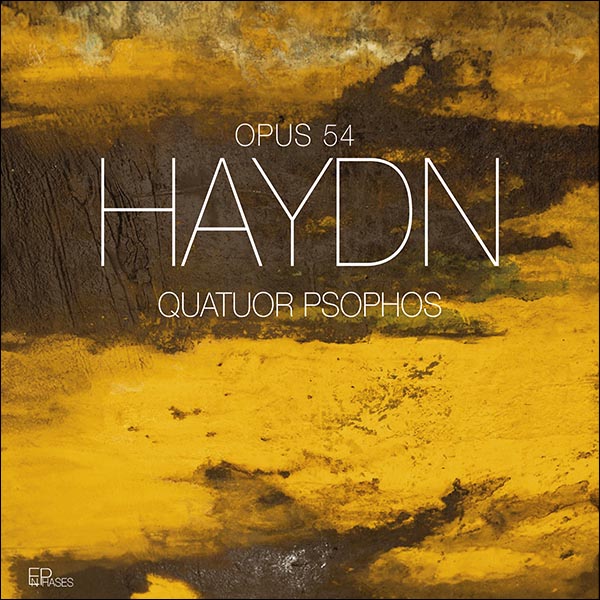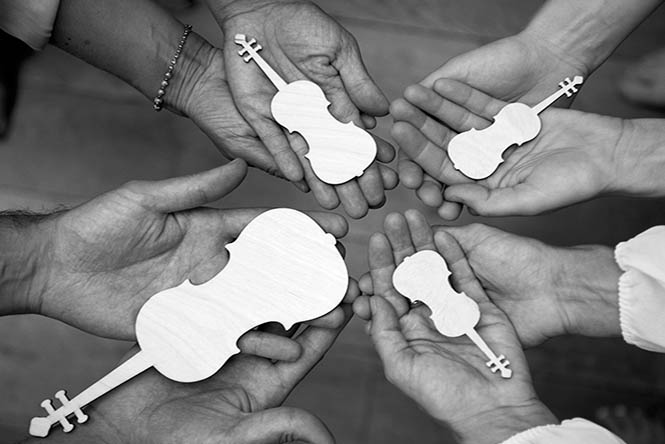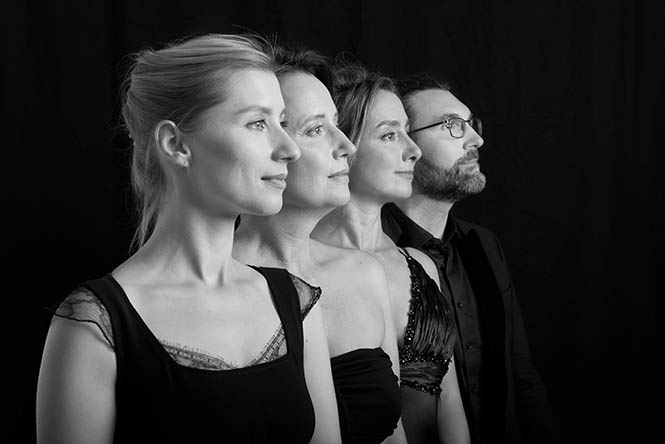Haydn - Opus 54

Haydn - Opus 54
QUATUOR PSOPHOS
Mathilde Borsarello Hermann, violin
Bleuenn Le Maître, violin
Cécile Grassi, viola
Guillaume Martigné, cello
LABEL ENPHASES - RELEASED ON 14/10/2022
Distribution Outhere - ENP009
--
Registered at: Soisson - 2022
Sound recording / Art direction / Editing:
Franck Jaffrès / Unik Access
Cover: Anne Bournas
Photo: Thomas Baltes
Design: Sybille Walter
Composed in 1788 and considered works of Haydn's full maturity as a composer, the quartets of Opus 54 immerse us in the bountiful universe of "the Father of the String Quartet ». Like with the Adagio of Op.54 n°2, his humanity and profundity fill us with wonder and remind us to what extent the very essence of the string quartet is exalted in this music.
Quatuor op. 54 n° 2 I. Vivace / 6.09
Quatuor op. 54 n° 2 II. Adagio / 4.12
Quatuor op. 54 n° 2 III. Menuet, Allegretto / 3.09
Quatuor op. 54 n° 2 IV. Finale, Adagio - Presto / 6.30
Quatuor op. 54 n° 1 I. Allegro con brio / 4.58
Quatuor op. 54 n° 1 II. Allegretto / 5.06
Quatuor op. 54 n° 1 III. Menuet / 3.25
Quatuor op. 54 n° 1 IV. Finale / 3.33
Quatuor op. 54 n° 3 I. Allegro / 5.36
Quatuor op. 54 n° 3 II. Largo cantabile / 8.34
Quatuor op. 54 n° 3 III. Menuet - Allegretto / 3.03
Quatuor op. 54 n° 3 IV. Finale - Presto / 4.07


About the project
Our six quartets appeared in two groups of three, with some time passing between their publication. Sieber published the first edition of the first three quartets, appearing in Paris in June 1789. In July a Viennese edition (Artaria) followed, and a London edition (Longman & Broderip) was published in August. Artaria received what was necessary for publication from its associate Sieber. The same publishers were responsible for the publication of the last three quartets from January to March 1790. The traditional opus numbers derive from the Sieber edition : 54 for the first three quartets, 55 for the three last ones. The works – if one refers to the traditional numbering – follow in the order n° 3, n°1, n°2 in the Sieber edition while the Longman & Broderip edition place them in the order n°2, n°1 and n° 3. The order n° 1, n°2, n°3 derives from Antaria, and is probably authentic. The complete Pleyel edition, adopted by Hoboken, is n° 2, n°1, n°3. Fragments of the autograph of two of the six quartets, the Op. 54 n° 1 and n°3, have survived.
There is nothing to indicate that Haydn was thinking of Johann Tost when working on the quartets Op. 54/55, which are without dedicatee, especially as we know nothing of Tost’s capacities as a violinist. In the first and last movements of Op. 54 n°1 and in the initial Vivace of Op. 54 n°2, the first violin part is extremely virtuosic. What’s more this part is rather eccentric in the two movements of the Op. 24 n°2 and n° 3. The Longman & Broderip edition specifies that the referred-to works had already been heard at the Professional Concert in Hanover Square, London, that is to say, in public. Perhaps Haydn, writing these quartets at the height of his international renown after the triumph of his six Parisian symphonies n° 82-87, knew that they would be : hence their spectacular aspect.
The quartet in G major Op. 54 n° 1 opens with an energetic and dense Allegro con brio whose first motif, with its eight successive Ds trampled in a staccato of quavers before a jump of an octave, is typical of Haydn. After some agile semiquavers, we hear a terse conclusive phrase in the 12th measure : once again four successive Ds of drummed-out quavers, followed this time by a descending scale fragment landing on the tonic G. The phrase is immediately repeated which effectively concludes the movement. The Allegretto in C major in 6/8 time, in sonata form without repeat, begins in a pleasant way and then has the first violin rise to vertiginous heights. Following a cadence in the dominant G major, in measure 35 we hear a most adventurous and mysterious episode : it fixes itself briefly in B flat then in D flat major before returning to G major after 12 measures in a gripping crescendo in chords emerging into a flight of the first violin into the upper register : an eruption of light in the darkness, no doubt a Masonic allusion. The Menuet brings us back to earth. In the first part of the trio the first violin is silent, the cello with its even quavers supports the melody of the second violin accompanied by the viola. The last movement, Presto, is a dazzling rondo-sonata. Its general allure is close to the corresponding movement of the Symphony n° 88, in the same key, in particular in the coda with its sudden wave of semiquavers. But in this case the end loses itself pianissimo in the upper registers.
The quartet in C major Op. 54 n°2 has a rather unorthodox structure. The main theme of the initial Vivace is made up of two phrases of six measures of which the last one (measures 6 and 12) contains a rest each time. With no transition, the music goes into A flat major in measure 13, and we get to the tonic thanks to a cadence formula in measures 23-25 (for perfect symmetry this would normally be measures 22-24). In this sonata form, the recapitulation is almost as long as the exposition and the development combined. Its first half is to a large extent an exact repeat of the exposition. The adventurous second half proposes new ideas, although there is a reappearance of the ‘second theme’. The Adagio in C minor in ¾ time is extremely strange. An eight-measure plaintive melody moving from C minor to G minor is announced by the first violin supported by the other three instruments, then taken up again three times like a cantus firmus, more or less modified and with different ins-trumentation (second violin sometimes in double chords). Rhapsodic figurations by the first violin interspersed with rubati (written and not improvised) are suspended over the melody : masterful assimilation of the tzigane (gypsy) style. The Menuet in C major follows without interruption, at first tentatively. The nuance intensifies gradually and only reaches fortissimo at the end, which paves the way for the savage and dramatic unissons that open the Trio in C minor. We see here a sans-culotte forcing his way through the doors of an aristocratic salon, and we are again in the key of the Adagio and its harrowing dissonances. The finale is a new surprise and opens with a slow tempo (Andante in C major). It seems like an introduction, but the tempo is maintained until measure 39 (a beautiful cantilena opposing the first violin and the cello in the upper register) then unexpectedly in C minor for another 17 measures. After a fermata suspends the flow, there is a dash into a Presto in C major, constructed like the refrain of a rondo with written repeats. A few measures of transition and a new fermata in the upper registers lead to a short return of the Adagio. Thus a slow tempo in a pianissimo nuance ends this exceptional quartet, of the kind ‘quasi una fantasia’. Officially in C major, there are three important episodes in the minor key. Not as well-known as the other two, the opening measures of the Allegro of the quartet in E major Op. 54 n° 3 shows to what point Haydn’s quartets where the musical equivalent of the art of conversation, which reached its highest point in the 18th century. The second violin and the viola begin the “conversation” in the middle of a phrase in the middle register and are interrupted by the first violin after one measure in a slightly higher register. The second violin and the viola begin again (measure 5) but the first violin interrupts them again. In desperation, the second violin takes up the phrase of the first violin in measure 9. But the first violin interrupts once again, this time assertively, by repeating the end of its earlier phrases and continuing the line as if nothing had happened in the meantime, and ends up dominating its partners. Haydn’s dramatic style ! A very ornamented Adagio in A major follows, in an A-B-Aʹ Lied form. This was the source of inspiration for Schubert in the corresponding movement of the last quartet of his youth, also in E major (n° 11 D. 353 of 1816.) In the middle B episode in A minor, the first violin dazzles us with incredible figurations based on a descending motif which in the A section and the Aʹ section is used by the cello to respond to the other instruments. These figurations are just as virtuosic as those of the Adagio in Op. 54 n° 2, but less emotionally charged. After a very rhythmic Minuet (Allegretto) with trio which begins with the four instruments à l’unisson comes a finale (Presto) in sonata form, and like the initial Vivace with its monothematic approach. After two measures of development a false recapitulation emerges, but cut short. Further on, dramatic rests make their sudden appearance and the line is broken up. The actual recapitulation is sidestepped, and we conclude with a sonorous empty fifth, E – B, in the same way as in the first movement.
Marc VIGNAL - Translation John Skippen
Share on your networks!
Follow us on the networks!

